Starter (Lessons 1~4)讲练课件(共52张PPT) 2023-2024学年英语牛津译林版七年级上册
文档属性
| 名称 | Starter (Lessons 1~4)讲练课件(共52张PPT) 2023-2024学年英语牛津译林版七年级上册 | 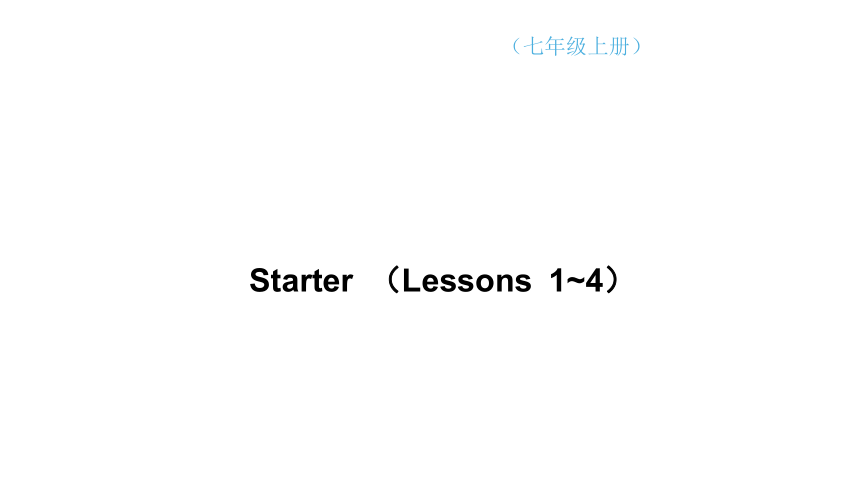 | |
| 格式 | pptx | ||
| 文件大小 | 489.4KB | ||
| 资源类型 | 教案 | ||
| 版本资源 | 牛津译林版 | ||
| 科目 | 英语 | ||
| 更新时间 | 2024-05-23 14:13:23 | ||
图片预览

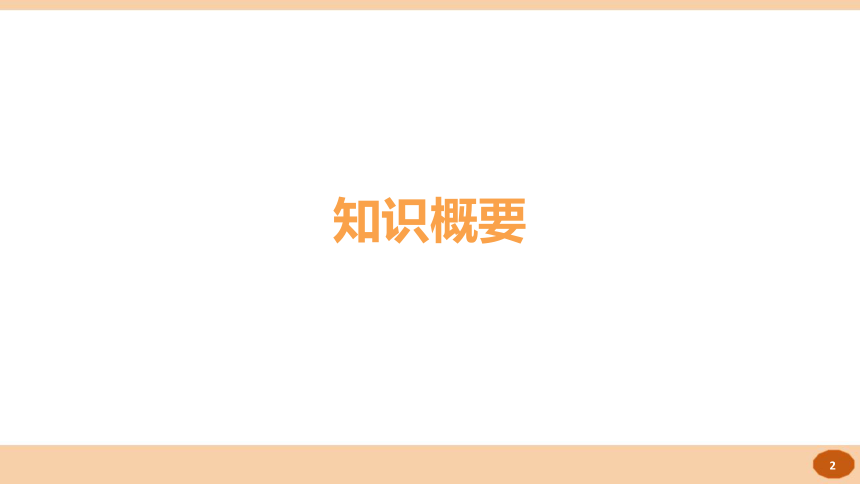
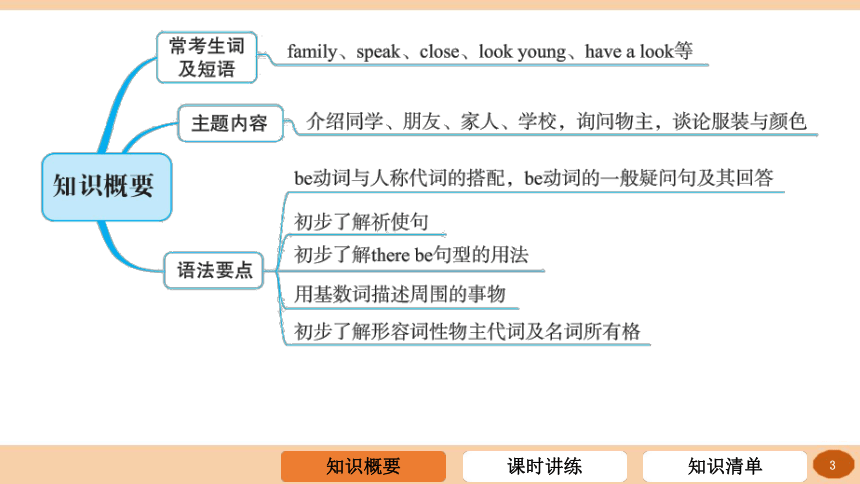

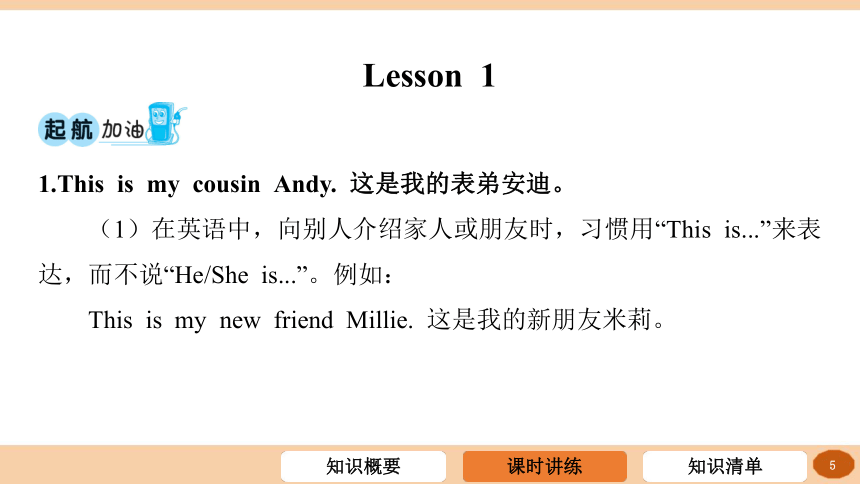
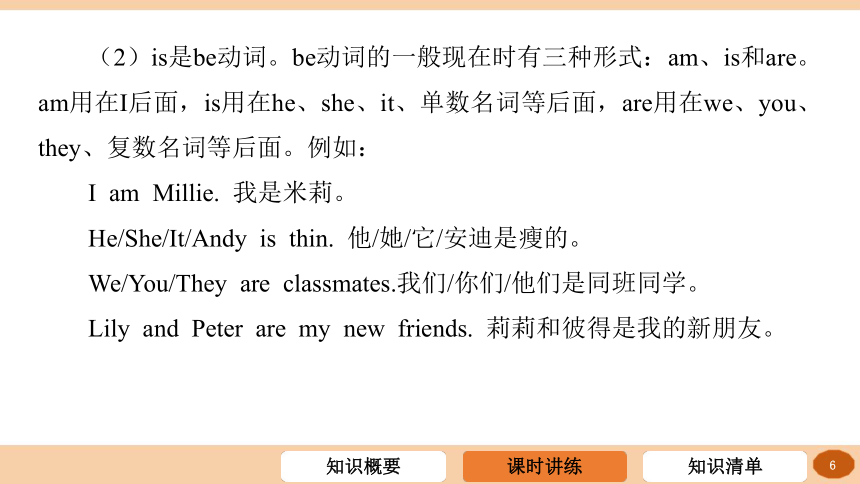
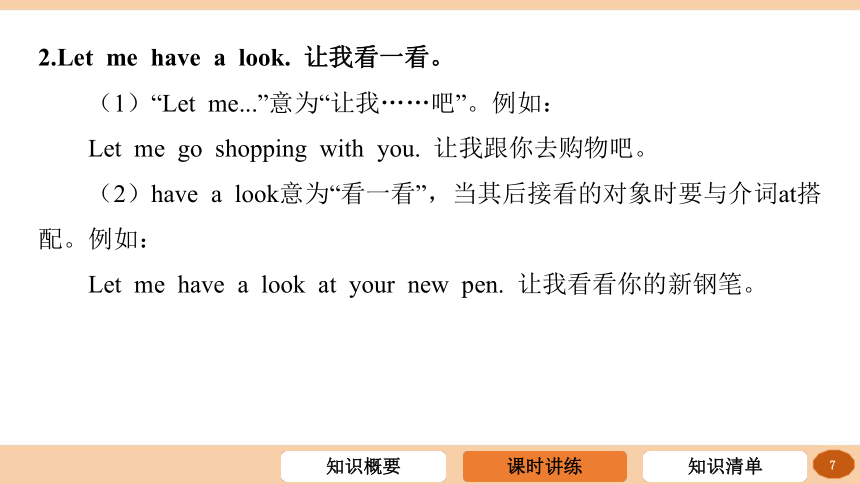

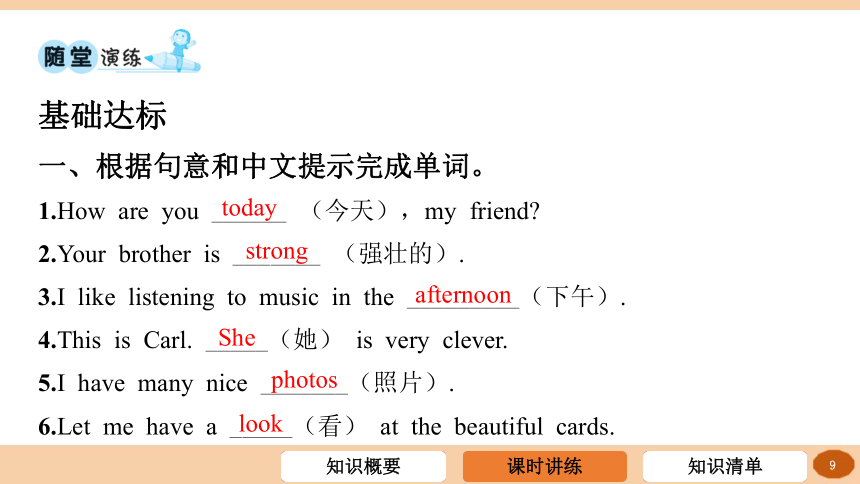
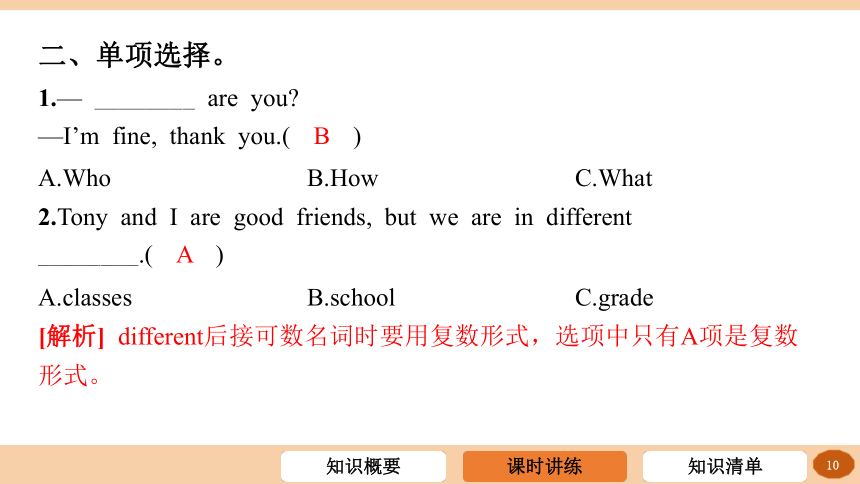
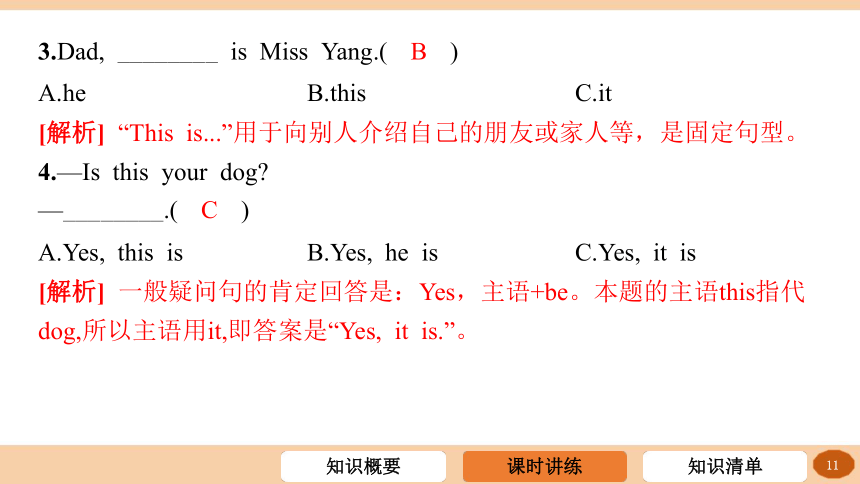
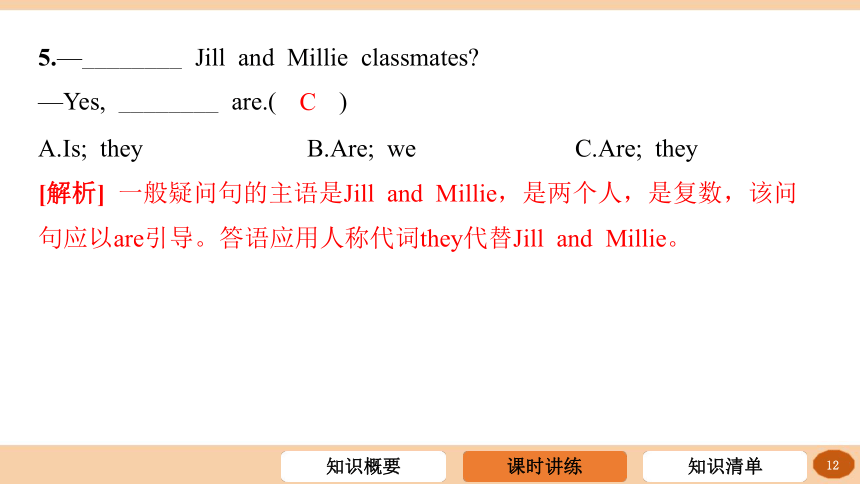
文档简介
(共52张PPT)
Starter (Lessons 1~4)
知识概要
课时讲练
1.This is my cousin Andy. 这是我的表弟安迪。
(1)在英语中,向别人介绍家人或朋友时,习惯用“This is...”来表达,而不说“He/She is...”。例如:
This is my new friend Millie. 这是我的新朋友米莉。
Lesson 1
(2)is是be动词。be动词的一般现在时有三种形式:am、is和are。am用在I后面,is用在he、she、it、单数名词等后面,are用在we、you、they、复数名词等后面。例如:
I am Millie. 我是米莉。
He/She/It/Andy is thin. 他/她/它/安迪是瘦的。
We/You/They are classmates.我们/你们/他们是同班同学。
Lily and Peter are my new friends. 莉莉和彼得是我的新朋友。
2.Let me have a look. 让我看一看。
(1)“Let me...”意为“让我……吧”。例如:
Let me go shopping with you. 让我跟你去购物吧。
(2)have a look意为“看一看”,当其后接看的对象时要与介词at搭配。例如:
Let me have a look at your new pen. 让我看看你的新钢笔。
3.It’s Lily’s dog Spotty. 它是莉莉的狗“点点”。
句中有两个’s,请注意区别:
It’s是It is的缩略形式,意思是“它是”。Lily’s是名词所有格形式,表示“某人的”,此处意为“莉莉的”。
基础达标
一、根据句意和中文提示完成单词。
1.How are you ______ (今天),my friend
today
2.Your brother is _______ (强壮的).
strong
3.I like listening to music in the _________(下午).
afternoon
4.This is Carl. _____(她) is very clever.
She
5.I have many nice _______(照片).
photos
6.Let me have a _____(看) at the beautiful cards.
look
二、单项选择。
1.— ________ are you
—I’m fine, thank you.( )
B
A.Who B.How C.What
2.Tony and I are good friends, but we are in different
________.( )
A
A.classes B.school C.grade
[解析] different后接可数名词时要用复数形式,选项中只有A项是复数形式。
3.Dad, ________ is Miss Yang.( )
B
A.he B.this C.it
[解析] “This is...”用于向别人介绍自己的朋友或家人等,是固定句型。
4.—Is this your dog
—________.( )
C
A.Yes, this is B.Yes, he is C.Yes, it is
[解析] 一般疑问句的肯定回答是:Yes,主语+be。本题的主语this指代dog,所以主语用it,即答案是“Yes, it is.”。
5.—________ Jill and Millie classmates
—Yes, ________ are.( )
C
A.Is; they B.Are; we C.Are; they
[解析] 一般疑问句的主语是Jill and Millie,是两个人,是复数,该问句应以are引导。答语应用人称代词they代替Jill and Millie。
三、根据中文意思完成英文句子。每空一词。
1.我们是同班同学。 (Page 6)
We ____ __________.
are
classmates
2.让我看看。(Page 7)
Let me _____ ___ _____.
have
a
look
3.这是你的狗吗,米莉?(Page 7)
___ this _____ dog, Millie
Is
your
4.你叫什么名字?(Page 8)
_______your name
What’s
5.米莉,今天你好吗?(Page 8)
______ are you ______, Millie
How
today
Lesson 2
1.Who’s the woman with long hair 这位长发女子是谁?
who是疑问代词,意为“谁”,用于询问某人的身份。例如:
Who’s the man at the school gate 校门口的那个男子是谁?
还可以用介词with引出某人的外貌特征,让指示更加明确。例如:
Who’s the girl with big eyes over there 那边那个大眼睛的女孩是谁?
【即时训练】
The woman___ glasses is my mother.
C
A.on B.in C.with
2.I have no brothers or sisters, but I have cousins. 我没有兄弟姐妹,但我有堂(表)亲。
在英语中,and常用于连接肯定句中的并列成分,意为“和”;or则用于连接否定句中的并列成分,意为“也不,也没”。例如:
I have a brother and a sister. 我有一个哥哥和一个妹妹。
They have no dogs or cats. 他们不养狗,也不养猫。
3.What’s he 他是做什么工作的?
句型“What be sb ”用于询问某人的职业,相当于“What does/do sb do ”。例如:
—What’s your uncle /What does your uncle do 你的叔叔是做什么工作的?
—He’s a bus driver. 他是一名公共汽车司机。
【即时训练】
—___ is Mrs Liu
—She is a teacher.
B
A.Who B.What C.How
基础达标
一、根据句意和中文提示完成单词。
1.Can Jenny ______(讲) Chinese
speak
2.Peter has a happy _______(家庭).
family
3.Mrs Li is forty-two, but she looks very _______(年轻的).
young
4.There are ______(三十) girls in our class.
thirty
5.My father is a doctor in a________(医院).
hospital
二、单项选择。
1.Amy has no sisters, ________ she has a brother.( )
B
A.or B.but C.and
2.Our Maths teacher is a man. We can call him ________ Chen.( )
A
A.Mr B.Mrs C.Ms
3.—Who’s the woman ________ long hair
—She’s my mum. She’s a teacher.( )
C
A.in B.on C.with
4.________ father a doctor ( )
A
A.Is your B.Are your C.Is you
[解析] 空格后有名词father,空格处应用形容词性物主代词,且因father是单数形式,该问句应用is引导。
5.—What’s your aunt
—________( )
B
A.She is tall. B.She’s a taxi driver. C.She has long hair.
[解析] 固定句型“What be sb ”用于提问职业,下文答语应就职业回答。
三、根据中文意思完成英文句子。每空一词。
1.这是我的一张全家福。(Page 10)
This is a ______ ___ my family.
photo
of
2.长着长头发的那个女子是谁?(Page 10)
_______ the woman _____ long hair.
Who’s
with
3.我十二岁了。(Page 11)
I am _______ ______ old.
twelve
years
4.她会讲英语。(Page 11)
She ____ ______ English。
can
speak
5.我没有兄弟和姐妹,但是我有表兄妹。(Page 11)
I have no brothers ___ _______, but I have ________.
or
sisters
cousins
Lesson 3
1.It’s time for class. 上课的时间到了。
句型“It is time for+名词/动名词”表示“是该做某事的时候了”。例如:
It’s time for breakfast. 是该吃早饭的时候了。
2.Read the new words after me. 跟我读这些生词。
这是一个祈使句,省略了主语,它的主语是听话者(you),一般不需要说出来。祈使句通常以动词原形开头。有时候为了表示礼貌,我们可以在祈使句的句首或句末加上please。例如:
Please come with me. 请跟我来。
【拓展】否定式的祈使句通常以do not或don’t开头。例如:
Don’t be late for school again. 别再上学迟到了。
3.There are sixteen boys and fourteen girls in my class. 我的班上有十六个男孩和十四个女孩。
句型“There is/are +名词+地点状语/时间状语”表示“某地/某时有……”。例如:
There are two pens on the desk. 书桌上有两支钢笔。
There is a class meeting on Friday afternoon. 周五下午有个班会。
基础达标
一、根据句意和中文提示完成单词。
1.Now please ______(打开) your books and turn to Page 20.
open
2.Look, there is a _____(灯) on the table.
light
3._________(欢迎) to our school, Simon!
Welcome
4.Please ______(听) to the tape again.
listen
5.There are two new _______(词) in this sentence(句子).
words
二、单项选择。
1.Now close your books and look________ the blackboard.( )
A
A.at B.for C.up
2.—Is there a playground in your school
—Yes,________.( )
B
A.we have B.there is C.there are
3.Look! This is my classroom. The doors and windows ________
clean.( )
C
A.is all B.all are C.are all
[解析] all在句中常用于be动词之后,行为动词之前,且空格所在句的主语是复数形式,故用are all。
4.There ________ a map of China and three pictures on the
wall.( )
B
A.be B.is C.are
[解析] 在there be句型中,be的单复数形式由其后最靠近它的那个名词决定,即“就近一致”原则。句中最靠近be的那个名词map是单数形式,be动词应用is。
5.—How many music rooms are there in your school
—________.( )
C
A.Yes, there are B.No, there aren’t C.There are two
[解析] 上文是以how many引导的特殊疑问句,提问数量的多少,答语应表示数量。
三、根据中文意思完成英文句子。每空一词。
1.是上课的时候了。(Page 14)
It’s _____ ____ class.
time
for
2.打开你的书本,翻到第16页。(Page 14)
______ your books and _____ ___ page 16.
Open
turn
to
3.在你的练习本里写下你的答案。(Page 14)
______ ______ your answers in your exercise books.
Write
down
4.欢迎来到我们学校。(Page 15)
_________ ___ our school.
Welcome
to
5.你们学校有多少间教室?(Page 16)
______ ______ classrooms ____ ______ in your school
How
many
are
there
Lesson 4
1.Whose sweater is it 它是谁的毛衣?
疑问代词whose意为“谁的”,用于对句子中的物主代词或名词所有格提问。例如:
—Whose shirt is that
—It’s Peter’s (shirt). / It’s my shirt. / It’s mine.
【即时训练】
—___ ball is this
—It’s her ball, I think.
C
A.Who B.Who’s C.Whose
2.What’s your mum like 你妈妈是什么样子的?
“What’s sb like ”意为“某人怎么样?”,既可以用于询问对方的外貌、衣着,也可以用于询问对方的个性特征。句中like是介词,意为“……怎么样”。可以根据不同的语境从不同的角度来回答“What’s sb like ”。例如:
—What is your new friend John like 你的新朋友约翰怎么样?
—He is tall and strong. 他又高又壮。(描述外貌)
—He is kind and clever. 他善良又聪明。 (描述个性特征)
【即时训练】
—___ is your elder sister like
—She is nice and clever.
A
A.What B.Who C.How
基础达标
一、根据句意和中文提示完成单词。
1.This is a _____(蓝色的) shirt.
blue
2._______(谁的) socks are those
Whose
3.Jim, don’t _______(担心) about your dog. It will be OK.
worry
4.—Mum, what colour are my new ______(鞋子)
—They are white.
shoes
5.—Lily,can I ____(使用) your eraser
—Sure. Here you are.
use
二、单项选择。
1.—Can I use your bike
—Sorry, it’s not ________ bike.( )
C
A.I B.me C.my
[解析] 空格后有名词bike,空格处应该用形容词性物主代词,表示“谁的自行车”。
2.—Amy, you look sad(伤心的). What’s ________
—I can’t find my new pen.( )
B
A.that B.wrong C.this
[解析] 由答语可推知,问句意思应该是“怎么了”。“What’s wrong ”符合题意。
3.Please stop ________ and listen to the teacher carefully(认真
地).( )
C
A.talk B.to talk C.talking
[解析] 由句意“请停止谈话,认真听老师讲课。”可推知空格处应用talking,因为stop doing sth意为“停止做某事”,是固定搭配。
4.—________ shorts are they
—They’re Tom’s brown shorts.( )
A
A.Whose B.Who C.What
5.—________
—He is not tall but strong.( )
B
A.What’s your dad B.What’s your dad like C.How is your dad
[解析] 由答语可知,上文是就“外貌”提问,应用句型“What be sb like ”。
三、根据中文意思完成英文句子。每空一词。
1.——它们是谁的袜子?
——它们是我们的白袜子。(Page 19)
—_______ ______ are they
—_______ ___ our white socks.
Whose
socks
They
are
2.我能借一下你的自行车吗?(Page 20)
Can I ____ your bike
use
3.它是我的狗狗的球。(Page 20)
It’s ____ ______ ball.
my
dog’s
4.不要担心,你妈妈长什么样子?(Page 20)
______ _______. What’s your mum _____
Don’t
worry
like
5.请不要哭,我会帮你找到你的父母。(Page 20)
Please stop _______ and I’ll help you _____ your _______.
crying
find
parents
素养提升
四、阅读理解。
My English name is Jane. I’m 12. I’m from Beijing. Tina is 13. She is from London. We are good friends. She is my first friend from London. Her last name is Smith. Tina likes China and she has a pen friend in Shanghai. My phone number is 6325509. Tina’s phone number is 6995832. Tina and I are in Paris. We are in a middle school here. I gave(给) Tina a map of the school. She likes it.
Tina likes the colour green best. Her cup, pens and jacket are green. I like purple. My ruler, cup and phone are purple.
根据短文内容,判断下列句子的正(T)误(F)。
1.Tina is from Beijing.( )
F
2.Tina has a pen friend in Shanghai.( )
T
3.Jane gave her friend Tina a map of China.( )
F
4.Jane and Tina are in Paris now.( )
T
5.Purple is Tina’s favourite colour.( )
F
知识清单
重点短语
1.___________看一看
have a look
2.__________看起来年轻
look young
3.________起立
stand up
4.________坐下
sit down
5._______翻到
turn to
6.__________写下,记下
write down
7._________听
listen to
8.______________(一幅)中国地图
a map of China
9.____________阅览室
reading room
10._______________跟我读……
read...after me
11.________放好
put away
重点句型
1. How are you (today)? 你(今天)好吗?
2. Who’s the man/woman with long hair 长头发的那个男人/女人是谁
3. What’s he/she 他/她是做什么工作的?
4. It’s time for class. 该上课了。
5. Open your books and turn to Page 16. 打开你们的书本,翻到第16页。
6. There are sixteen boys and fourteen girls in my class. 在我班上有十六名男生和十四名女生。
7. Can I use your bike 我可以借用你的自行车吗?
8. What’s your mother like 你的母亲是什么样的
9. Don’t worry. 别担心。
10. Please stop crying and I’ll help you find your parents. 请不要哭了,我会帮你找到你父母的。
重点语法
1. be动词的一般疑问句及其答语。
2. there be句型的用法:表示“某地/某时有某物”。
3. 形容词性物主代词
形容词性物主代词:它通常与名词连用,在句子中作定语,不能单独使用。
Starter (Lessons 1~4)
知识概要
课时讲练
1.This is my cousin Andy. 这是我的表弟安迪。
(1)在英语中,向别人介绍家人或朋友时,习惯用“This is...”来表达,而不说“He/She is...”。例如:
This is my new friend Millie. 这是我的新朋友米莉。
Lesson 1
(2)is是be动词。be动词的一般现在时有三种形式:am、is和are。am用在I后面,is用在he、she、it、单数名词等后面,are用在we、you、they、复数名词等后面。例如:
I am Millie. 我是米莉。
He/She/It/Andy is thin. 他/她/它/安迪是瘦的。
We/You/They are classmates.我们/你们/他们是同班同学。
Lily and Peter are my new friends. 莉莉和彼得是我的新朋友。
2.Let me have a look. 让我看一看。
(1)“Let me...”意为“让我……吧”。例如:
Let me go shopping with you. 让我跟你去购物吧。
(2)have a look意为“看一看”,当其后接看的对象时要与介词at搭配。例如:
Let me have a look at your new pen. 让我看看你的新钢笔。
3.It’s Lily’s dog Spotty. 它是莉莉的狗“点点”。
句中有两个’s,请注意区别:
It’s是It is的缩略形式,意思是“它是”。Lily’s是名词所有格形式,表示“某人的”,此处意为“莉莉的”。
基础达标
一、根据句意和中文提示完成单词。
1.How are you ______ (今天),my friend
today
2.Your brother is _______ (强壮的).
strong
3.I like listening to music in the _________(下午).
afternoon
4.This is Carl. _____(她) is very clever.
She
5.I have many nice _______(照片).
photos
6.Let me have a _____(看) at the beautiful cards.
look
二、单项选择。
1.— ________ are you
—I’m fine, thank you.( )
B
A.Who B.How C.What
2.Tony and I are good friends, but we are in different
________.( )
A
A.classes B.school C.grade
[解析] different后接可数名词时要用复数形式,选项中只有A项是复数形式。
3.Dad, ________ is Miss Yang.( )
B
A.he B.this C.it
[解析] “This is...”用于向别人介绍自己的朋友或家人等,是固定句型。
4.—Is this your dog
—________.( )
C
A.Yes, this is B.Yes, he is C.Yes, it is
[解析] 一般疑问句的肯定回答是:Yes,主语+be。本题的主语this指代dog,所以主语用it,即答案是“Yes, it is.”。
5.—________ Jill and Millie classmates
—Yes, ________ are.( )
C
A.Is; they B.Are; we C.Are; they
[解析] 一般疑问句的主语是Jill and Millie,是两个人,是复数,该问句应以are引导。答语应用人称代词they代替Jill and Millie。
三、根据中文意思完成英文句子。每空一词。
1.我们是同班同学。 (Page 6)
We ____ __________.
are
classmates
2.让我看看。(Page 7)
Let me _____ ___ _____.
have
a
look
3.这是你的狗吗,米莉?(Page 7)
___ this _____ dog, Millie
Is
your
4.你叫什么名字?(Page 8)
_______your name
What’s
5.米莉,今天你好吗?(Page 8)
______ are you ______, Millie
How
today
Lesson 2
1.Who’s the woman with long hair 这位长发女子是谁?
who是疑问代词,意为“谁”,用于询问某人的身份。例如:
Who’s the man at the school gate 校门口的那个男子是谁?
还可以用介词with引出某人的外貌特征,让指示更加明确。例如:
Who’s the girl with big eyes over there 那边那个大眼睛的女孩是谁?
【即时训练】
The woman___ glasses is my mother.
C
A.on B.in C.with
2.I have no brothers or sisters, but I have cousins. 我没有兄弟姐妹,但我有堂(表)亲。
在英语中,and常用于连接肯定句中的并列成分,意为“和”;or则用于连接否定句中的并列成分,意为“也不,也没”。例如:
I have a brother and a sister. 我有一个哥哥和一个妹妹。
They have no dogs or cats. 他们不养狗,也不养猫。
3.What’s he 他是做什么工作的?
句型“What be sb ”用于询问某人的职业,相当于“What does/do sb do ”。例如:
—What’s your uncle /What does your uncle do 你的叔叔是做什么工作的?
—He’s a bus driver. 他是一名公共汽车司机。
【即时训练】
—___ is Mrs Liu
—She is a teacher.
B
A.Who B.What C.How
基础达标
一、根据句意和中文提示完成单词。
1.Can Jenny ______(讲) Chinese
speak
2.Peter has a happy _______(家庭).
family
3.Mrs Li is forty-two, but she looks very _______(年轻的).
young
4.There are ______(三十) girls in our class.
thirty
5.My father is a doctor in a________(医院).
hospital
二、单项选择。
1.Amy has no sisters, ________ she has a brother.( )
B
A.or B.but C.and
2.Our Maths teacher is a man. We can call him ________ Chen.( )
A
A.Mr B.Mrs C.Ms
3.—Who’s the woman ________ long hair
—She’s my mum. She’s a teacher.( )
C
A.in B.on C.with
4.________ father a doctor ( )
A
A.Is your B.Are your C.Is you
[解析] 空格后有名词father,空格处应用形容词性物主代词,且因father是单数形式,该问句应用is引导。
5.—What’s your aunt
—________( )
B
A.She is tall. B.She’s a taxi driver. C.She has long hair.
[解析] 固定句型“What be sb ”用于提问职业,下文答语应就职业回答。
三、根据中文意思完成英文句子。每空一词。
1.这是我的一张全家福。(Page 10)
This is a ______ ___ my family.
photo
of
2.长着长头发的那个女子是谁?(Page 10)
_______ the woman _____ long hair.
Who’s
with
3.我十二岁了。(Page 11)
I am _______ ______ old.
twelve
years
4.她会讲英语。(Page 11)
She ____ ______ English。
can
speak
5.我没有兄弟和姐妹,但是我有表兄妹。(Page 11)
I have no brothers ___ _______, but I have ________.
or
sisters
cousins
Lesson 3
1.It’s time for class. 上课的时间到了。
句型“It is time for+名词/动名词”表示“是该做某事的时候了”。例如:
It’s time for breakfast. 是该吃早饭的时候了。
2.Read the new words after me. 跟我读这些生词。
这是一个祈使句,省略了主语,它的主语是听话者(you),一般不需要说出来。祈使句通常以动词原形开头。有时候为了表示礼貌,我们可以在祈使句的句首或句末加上please。例如:
Please come with me. 请跟我来。
【拓展】否定式的祈使句通常以do not或don’t开头。例如:
Don’t be late for school again. 别再上学迟到了。
3.There are sixteen boys and fourteen girls in my class. 我的班上有十六个男孩和十四个女孩。
句型“There is/are +名词+地点状语/时间状语”表示“某地/某时有……”。例如:
There are two pens on the desk. 书桌上有两支钢笔。
There is a class meeting on Friday afternoon. 周五下午有个班会。
基础达标
一、根据句意和中文提示完成单词。
1.Now please ______(打开) your books and turn to Page 20.
open
2.Look, there is a _____(灯) on the table.
light
3._________(欢迎) to our school, Simon!
Welcome
4.Please ______(听) to the tape again.
listen
5.There are two new _______(词) in this sentence(句子).
words
二、单项选择。
1.Now close your books and look________ the blackboard.( )
A
A.at B.for C.up
2.—Is there a playground in your school
—Yes,________.( )
B
A.we have B.there is C.there are
3.Look! This is my classroom. The doors and windows ________
clean.( )
C
A.is all B.all are C.are all
[解析] all在句中常用于be动词之后,行为动词之前,且空格所在句的主语是复数形式,故用are all。
4.There ________ a map of China and three pictures on the
wall.( )
B
A.be B.is C.are
[解析] 在there be句型中,be的单复数形式由其后最靠近它的那个名词决定,即“就近一致”原则。句中最靠近be的那个名词map是单数形式,be动词应用is。
5.—How many music rooms are there in your school
—________.( )
C
A.Yes, there are B.No, there aren’t C.There are two
[解析] 上文是以how many引导的特殊疑问句,提问数量的多少,答语应表示数量。
三、根据中文意思完成英文句子。每空一词。
1.是上课的时候了。(Page 14)
It’s _____ ____ class.
time
for
2.打开你的书本,翻到第16页。(Page 14)
______ your books and _____ ___ page 16.
Open
turn
to
3.在你的练习本里写下你的答案。(Page 14)
______ ______ your answers in your exercise books.
Write
down
4.欢迎来到我们学校。(Page 15)
_________ ___ our school.
Welcome
to
5.你们学校有多少间教室?(Page 16)
______ ______ classrooms ____ ______ in your school
How
many
are
there
Lesson 4
1.Whose sweater is it 它是谁的毛衣?
疑问代词whose意为“谁的”,用于对句子中的物主代词或名词所有格提问。例如:
—Whose shirt is that
—It’s Peter’s (shirt). / It’s my shirt. / It’s mine.
【即时训练】
—___ ball is this
—It’s her ball, I think.
C
A.Who B.Who’s C.Whose
2.What’s your mum like 你妈妈是什么样子的?
“What’s sb like ”意为“某人怎么样?”,既可以用于询问对方的外貌、衣着,也可以用于询问对方的个性特征。句中like是介词,意为“……怎么样”。可以根据不同的语境从不同的角度来回答“What’s sb like ”。例如:
—What is your new friend John like 你的新朋友约翰怎么样?
—He is tall and strong. 他又高又壮。(描述外貌)
—He is kind and clever. 他善良又聪明。 (描述个性特征)
【即时训练】
—___ is your elder sister like
—She is nice and clever.
A
A.What B.Who C.How
基础达标
一、根据句意和中文提示完成单词。
1.This is a _____(蓝色的) shirt.
blue
2._______(谁的) socks are those
Whose
3.Jim, don’t _______(担心) about your dog. It will be OK.
worry
4.—Mum, what colour are my new ______(鞋子)
—They are white.
shoes
5.—Lily,can I ____(使用) your eraser
—Sure. Here you are.
use
二、单项选择。
1.—Can I use your bike
—Sorry, it’s not ________ bike.( )
C
A.I B.me C.my
[解析] 空格后有名词bike,空格处应该用形容词性物主代词,表示“谁的自行车”。
2.—Amy, you look sad(伤心的). What’s ________
—I can’t find my new pen.( )
B
A.that B.wrong C.this
[解析] 由答语可推知,问句意思应该是“怎么了”。“What’s wrong ”符合题意。
3.Please stop ________ and listen to the teacher carefully(认真
地).( )
C
A.talk B.to talk C.talking
[解析] 由句意“请停止谈话,认真听老师讲课。”可推知空格处应用talking,因为stop doing sth意为“停止做某事”,是固定搭配。
4.—________ shorts are they
—They’re Tom’s brown shorts.( )
A
A.Whose B.Who C.What
5.—________
—He is not tall but strong.( )
B
A.What’s your dad B.What’s your dad like C.How is your dad
[解析] 由答语可知,上文是就“外貌”提问,应用句型“What be sb like ”。
三、根据中文意思完成英文句子。每空一词。
1.——它们是谁的袜子?
——它们是我们的白袜子。(Page 19)
—_______ ______ are they
—_______ ___ our white socks.
Whose
socks
They
are
2.我能借一下你的自行车吗?(Page 20)
Can I ____ your bike
use
3.它是我的狗狗的球。(Page 20)
It’s ____ ______ ball.
my
dog’s
4.不要担心,你妈妈长什么样子?(Page 20)
______ _______. What’s your mum _____
Don’t
worry
like
5.请不要哭,我会帮你找到你的父母。(Page 20)
Please stop _______ and I’ll help you _____ your _______.
crying
find
parents
素养提升
四、阅读理解。
My English name is Jane. I’m 12. I’m from Beijing. Tina is 13. She is from London. We are good friends. She is my first friend from London. Her last name is Smith. Tina likes China and she has a pen friend in Shanghai. My phone number is 6325509. Tina’s phone number is 6995832. Tina and I are in Paris. We are in a middle school here. I gave(给) Tina a map of the school. She likes it.
Tina likes the colour green best. Her cup, pens and jacket are green. I like purple. My ruler, cup and phone are purple.
根据短文内容,判断下列句子的正(T)误(F)。
1.Tina is from Beijing.( )
F
2.Tina has a pen friend in Shanghai.( )
T
3.Jane gave her friend Tina a map of China.( )
F
4.Jane and Tina are in Paris now.( )
T
5.Purple is Tina’s favourite colour.( )
F
知识清单
重点短语
1.___________看一看
have a look
2.__________看起来年轻
look young
3.________起立
stand up
4.________坐下
sit down
5._______翻到
turn to
6.__________写下,记下
write down
7._________听
listen to
8.______________(一幅)中国地图
a map of China
9.____________阅览室
reading room
10._______________跟我读……
read...after me
11.________放好
put away
重点句型
1. How are you (today)? 你(今天)好吗?
2. Who’s the man/woman with long hair 长头发的那个男人/女人是谁
3. What’s he/she 他/她是做什么工作的?
4. It’s time for class. 该上课了。
5. Open your books and turn to Page 16. 打开你们的书本,翻到第16页。
6. There are sixteen boys and fourteen girls in my class. 在我班上有十六名男生和十四名女生。
7. Can I use your bike 我可以借用你的自行车吗?
8. What’s your mother like 你的母亲是什么样的
9. Don’t worry. 别担心。
10. Please stop crying and I’ll help you find your parents. 请不要哭了,我会帮你找到你父母的。
重点语法
1. be动词的一般疑问句及其答语。
2. there be句型的用法:表示“某地/某时有某物”。
3. 形容词性物主代词
形容词性物主代词:它通常与名词连用,在句子中作定语,不能单独使用。
同课章节目录
- 预备课程
- Lesson 1 Nice to meet you !
- Lesson 2 A happy family
- Lesson 3 A nice school
- Lesson 4 You look cool !
- Lesson 5 Wonderful things
- Lesson 6 Have nice food
- Lesson 7 Enjoy our days
- Lesson 8 Let's have fun !
- Unit 1 This is me
- Unit 2 Let's play sports
- Unit 3 Welcome to our school
- Unit 4 My day
- Unit 5 Let’s celebrate
- Unit 6 Food and lifestyle
- Unit 7 Shopping
- Unit 8 Fashion
